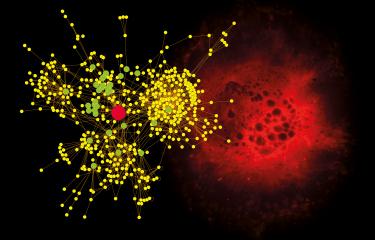A candidate vaccine for treating cervical cancers has just been proven effective in animals by researchers at the Institut Pasteur in cooperation with the French National Health and Medical Research Institute (Inserm) and the French National Center for Scientific Research (CNRS), and by the company BT PHARMA*, an Institut Pasteur start-up company. This therapeutic vaccine is directed against a papillomavirus that is the cause of most cervical cancers. These results, published in Cancer Research, pave the way to clinical trials in humans. It is important to remember that on a global scale, cervical cancer is the second most frequent cancer occurring in women.
Press release
Paris, january 17, 2005
Cervical cancer is caused by sexually transmitted infections due to certain papillomaviruses (HPV). This is the first cancer to be recognized by the World Health Organization as being 100% attributable to an infection. Each year, it causes 230,000 deaths throughout the world and 500,000 new cases (80% in developing countries), according to the World Health Organization’s International Agency for Research on Cancer. In Europe, 65,000 women are affected, and approximately 25,000 new cases are reported each year, with a mortality rate of 4.7%.
The therapeutic effectiveness of a candidate vaccine directed against human papillomavirus 16 (HPV16), which is responsible for 55% of cervical cancers, has been proven by the collaborative effort between Xavier Préville (BT PHARMA), the team led by Claude Leclerc** (Institut Pasteur Biology of Immune Regulations Unit, Inserm E352), and the team led by Daniel Ladant (Institut Pasteur Biochemistry of Macromolecular Interactions Unit - URA 2185 CNRS).
The underlying principle of therapeutic vaccination, which is a form of immunotherapy, is to induce an immune response against a specific component of the targeted tumor cells (tumor antigen), a response that results in the production of "killer cells" that are capable of destroying the tumor very specifically.
The candidate vaccine comprises fragments of onco-protein E7 of HPV16, that are genetically engineered into a bacterial protein that serves as a vector (CyaA of Bordetella pertussis). Protein E7 of the papillomavirus is expressed by the neoplastic cells in pre-carcinogenic lesions and cervical tumors and is categorized as a tumor antigen.
Administered to mice with tumors that model human cancer, this protein vaccine causes full tumor regression in 100% of the animals, and does so with a single injection and without an adjuvant. This great effectiveness is partly due to the vaccine vector used, which targets the best performing cells in order to introduce the vaccine antigen into the immune system: dendritic cells. This is also a purified protein vaccine, which is stable and easy to produce. These characteristics give it advantages over other therapeutic candidate vaccines that are already undergoing clinical testing throughout the world.
These same teams have also obtained results with a therapeutic vaccine directed against oncoprotein E7 of HPV18, which causes 12% of cervical cancers. A clinical trial combining both candidate vaccines that focuses on the treatment of neoplastic lesions before they develop into cervical cancers, should be launched in the beginning of 2006 by BT PHARMA. This vaccine combination, if its effectiveness is confirmed in humans, could make it possible to avoid nearly 70% of cervical cancers.
As a reminder, a preventive vaccine against oncogenic genital papillomavirus infections is currently in large scale (phase III cinical trials). However, once an HPV infection has occured, the appearance of pre-carcinogenic lesions and subsequently cancer is a slow process (5 to 15 years). A preventive vaccine would therefore not prevent the some 5 million deaths by cervical cancers that are estimated to occur in the next 20 years due to current infections and already existing pre-carcinogenic lesions.
These results also confirm the advantages of the CyaA vector developed by researchers at the Institut Pasteur. This vector has already enabled the teams led by Claude Leclerc and Daniel Ladant to develop a therapeutic candidate vaccine against malignant melanoma, which is scheduled for testing in humans at the end of 2006.
*BT PHARMA is originally a spin-off of the Institut Pasteur’s comany incubator, Pasteur Biotop (October 2001). The company is now operating at Prologue-Biotech, in Labège, France. Its objective is to improve human health by developing cancer immunotherapy and vaccines against certain infectious diseases.
** Claude Leclerc is the Chairman of the Institut Pasteur "Cancer Committee," which is part of Canceropôle Ile-de-France.
Sources
"Eradication of established tumors by vaccination with recombinant Bordetella pertussis Adenylate Cyclase carrying the human papillomavirus 16 E7 oncoprotein" : Cancer Research, 15 janvier 2005.
Xavier Préville (1,2), Daniel Ladant (3), Benedikt Timmerman (1) et Claude Leclerc (2)
1. BT PHARMA, incubateur Pasteur Biotop, Institut Pasteur, Paris
2. Unité de Biologie des Régulations Immunitaires (Inserm E352), Institut Pasteur, Paris
3. Unité Postulante de Biochimie des Interactions Macromoléculaires (CNRS), Institut Pasteur, Paris
Contact press
Institut Pasteur Press Department
Nadine Peyrolo
01 44 38 91 30 - npeyrolo@pasteur.fr
Corinne Jamma
01 40 61 33 41 - cjamma@pasteur.fr
Inserm Press Department
Séverine Ciancia
01 44 23 60 86 - ciancia@tolbiac.inserm.fr
CNRS Press Department
Claire Le Poulennec
01 44 96 49 88 - claire.le-poulennec@cnrs-dir.fr



